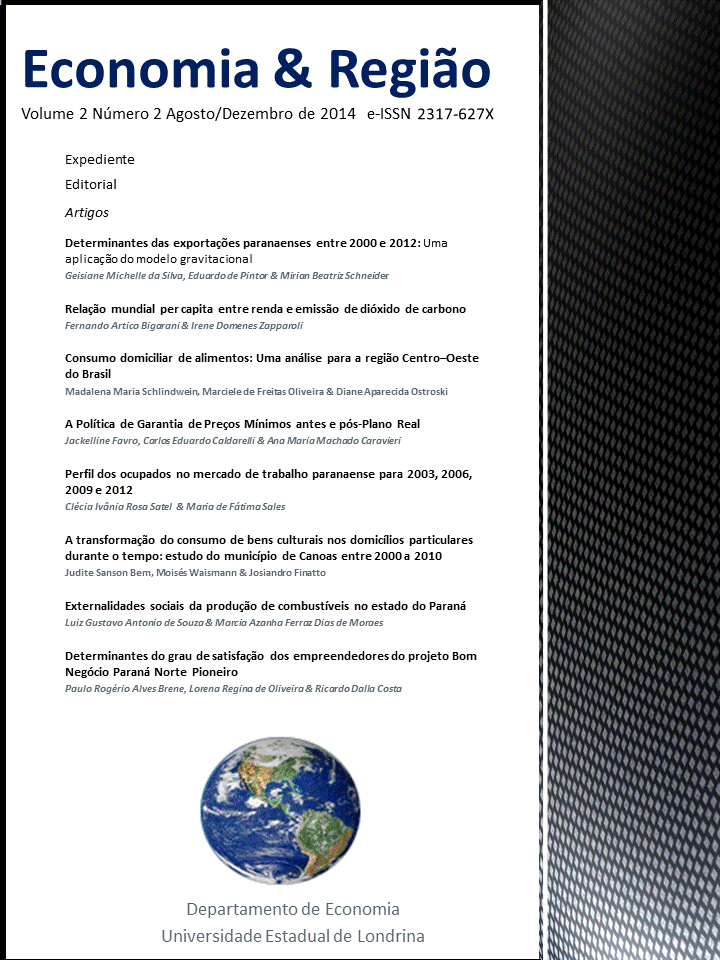Social externality of fuel production in Paraná state
DOI:
https://doi.org/10.5433/2317-627X.2014v2n2p115Keywords:
Sugarcane, Ethanol, oil, Gasoline, cluster, Social externalityAbstract
The accentuation of the climate change effects generates a positive prospect for the use of bioenergy at the expense of fossil fuels. There is an expansion of sugarcane in the state of Paraná. This growth combined with installation of new plants or expanding production capacity will benefit directly and indirectly the locational economic dynamics of cities. The aim of this paper is to understand the relevance of related economic activities to the production of ethanol compared to petroleum-based fuels amid new prospects. This article discusses the concept of productive agglomerations in the sectors in question from the perspective of social externalities. The indicator location quotient (LQ) is used as a proxy for the presence of agglomeration and thus production of presence of social externalities. Formal jobs data were used from the Annual List of Social Information (RAIS) for sugarcane, ethanol, oil extraction and oil products sectors. In this case, it was found that the sugarcane and ethanol production sectors are relevant in the state, which leads to the inference of the presence of agglomeration and externalities economies. In the oil extraction industry and derivatives, however, its performance is incipient and timely. The results showed that the high capillarity from the sugarcane and ethanol sector can generate both a positive externality as a vulnerability.Downloads
References
BELIK, W.; SOUZA, L. G. A.; FIGUEIRA, S. R.; KOGA-VICENTE, A.; ZULLO JUNIOR, J. The Situation and prospects of the Brazilian sugarcane industry facing the macroeconomic scenarios and climate change. In: 10th Conference on Sustainable Development of Energy, Water and Environment Systems, Dubrovinik, 2015.
CASSIOLATO, J.; LASTRES, H. M. M. O foco em arranjos produtivos e inovativos locais de micro e pequenas empresas. In: LASTRES, H.M.M; CASSIOLATO, J.E.; MACIEL, M.L. (Org). Pequena empresa: cooperação e desenvolvimento local. Relume Dumará: Rio de Janeiro, 2003. Disponível em: http://www.comunidade.sebrae.com.br/procompi/Assuntos+sobre+APL/Downloads_GetFile.aspx?id=1994. Acesso em: 08 ago. 2012.
FURTADO, A. T; SCANDIFFIO, M. I. G.; CORTEZ, L. A. B. The Brazilian sugarcane innovation system, Energy Policy, v. 39, n. 1, p. 156-166, 2011.
HANSON, Gordon. Increasing returns, trade and the regional structure of wages. Economic Journal, v. 107, p. 113-133, 1997.
HENDERSON, J. V. Marshall's scale economies. NBER Working Paper, n. 7358, Sep. 1999.
GALINARI, R.; CROCCO, M. A.; LEMOS, M. B.; BASQUES, M. F. D. O efeito das economias de aglomeração sobre os salários industriais: uma aplicação ao caso brasileiro. Revista de Economia Contemporânea, v. 11, p. 391-420, 2007.
IBGE - Instituto Brasileiro de Geografia e Estatística, Disponível em: http://www.ibge.gov.br. Acesso em: 20 maio de 2009.
IPARDES - Instituto Paranaense de Desenvolvimento Econômico e Social. Dados do Estado (BDEweb). Disponível em: http://www.ipardes.gov.br/imp/index.php. Acesso em: 15 dez. 2009.
MANZATTO, C. V.; ASSAD, E. D.; BACCA, J. F. M.; ZARONI, M. J.; PEREIRA, S. E. M. Zoneamento agroecológico da cana-de-açúcar: expandir a produção, preservar a vida, garantir o futuro. Rio de Janeiro: Embrapa Solos, 2009. 55 p.
MARSHALL, A. Princípios de Economia: tratado introdutório. São Paulo: Nova Cultural, 1996. v.1, 368 págs.
MILLER; R. E.; BLAIR, P. D. Input-output analysis: foundations and extensions. 2. ed. Cambridge: Cabridge University Press, 2009. 750 p.
MORAES, M. A. F. D. A desregulamentação do setor sucroalcooleiro do Brasil. Americana: Caminho Editorial, 2000. 238 p.
MORAES, M. A. F. D.; COSTA, C. C.; GUILHOTO, J. J. M.; SOUZA, L. G. A.; OLIVEIRA, F. C. R. Externalidades sociais dos combustíveis. In: Isaias de Carvalho Macedo; Eduardo Leão de Sousa. (Org.). Etanol e Bioeletricidade: a cana-de-açúcar no futuro da matriz energética. São Paulo: União da Indústria de Cana-de-Açúcar, 2010, v. 1, p. 44-75.
PEREIRA, F. M. Cidades médias brasileiras: uma tipologia a partir das (des)economias de aglomeração. 2002 (Dissertação de Mestrado em Economia) - Universidade Federal de Minas Gerais, Belo Horizonte, 2002.
PORTER, M. Clusters and the new economics of competition. Harvard Business Review, nov-dez, p.77-90, 1998.
RAIS - Relação Anual de Informações Sociais - Ministério do Trabalho e Emprego (MTE). Banco de dados do sistema online. Disponível em: http://www.mte.gov.br/EstudiososPesquisadores/default.asp. Acesso e: 20 dez. 2009.
SOUZA, L. G. A. Redes de inovação em etanol de segunda geração. 2013. Tese (Doutorado em Economia Aplicada) - Escola Superior de Agricultura Luiz de Queiroz, Universidade de São Paulo, Piracicaba, 2013. Disponível em: http://www.teses.usp.br/teses/disponiveis/11/11132/tde-26082013-135850/. Acesso em: 6 ago. 2013.
SUZIGAN, W. et al. Aglomerações industriais no Estado de São Paulo. Instituto de Economia, Universidade de Campinas (UNICAMP). São Paulo: Brasil, 2000.
UNIÃO DA INDÚSTRIA DA CANA-DE-AÇÚCAR (UNICA). Dados sobre a área plantada de cana-de-açúcar no Brasil. São Paulo: 2015. Disponível em: http://www.unicadata.com.br. Acesso em: 10 jan. 2015.
Downloads
Published
How to Cite
Issue
Section
License
Copyright (c) 2014 Economia & Região

This work is licensed under a Creative Commons Attribution 4.0 International License.
Economia & Região adota a Licença Creative Commons Attribution CC-BY 4.0 International, portanto, os direitos autorais relativos aos artigos publicados são do(s) autor(es), que cedem à Revista Economia & Região o direito de exclusividade de primeira publicação.
Sob essa licença é possível: Compartilhar - copiar e redistribuir o material em qualquer suporte ou formato. Adaptar - remixar, transformar, e criar a partir do material, atribuindo o devido crédito e prover um link para a licença e indicar se mudanças foram feitas.




















